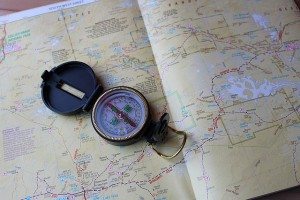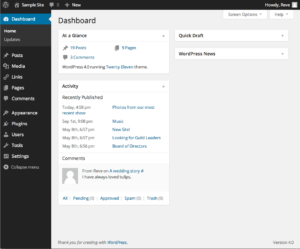
Did you have a WordPress site set up for you? Are you now in charge of keeping it up to date? I have a series for you. Over this week and next we’ll cover the basics of using WordPress, including short videos from iThemes. All of the videos plus other information are in my Pinterest board WordPress Tutorials and Tips, and if you are starting a site you may also be interested in my boards So You Want To Get A Website and WordPress Plugins We Use. Pinterest can be a little harder to sift through, so this series puts the videos in order and adds more context and my own tips.
The plan:
1. Logging in and getting around – you are here
2. Creating and editing posts and pages
3. More aspects of posts and pages
4. Inserting images into posts and pages
5. Comments and your account
6. Widgets (sidebar content)
Logging in and getting around
The login page of your site is at your-site-address/wp-login.php, and once you are logged in you’ll be at your-site-address/wp-admin/. That is where all the action happens. In fact, you can use the wp-admin address directly; it will sidetrack you to the login page if you are not logged in.
A little vocabulary: The front end of your site is the part visitors see; the back end is the part that makes the front end happen. You’ll make changes to your site from the admin area. The first page you reach in the WordPress admin area is called the Dashboard (screenshot below), and you’ll sometimes see the entire admin area referred to as such (though properly it is just that one page). At the top of the screen when you are logged in you’ll see the Toolbar, which is basically a menu bar.
One general principle: in the WordPress admin there are a lot of drop-down and pop-out submenus. In every case, clicking the item that has the submenu is the same as clicking the first entry of the submenu. For instance, clicking “Posts” is the same as clicking “All Posts”.
The Toolbar has some convenient quick links. Your site name, on the left, will take you between the front and back end of the site. Your user name, on the right, drops down a menu that includes “Log Out”. The following is a screenshot of the left half of the Toolbar from a page on the front end of the site.
Admin pages consist of a collection of content boxes called panels. Panels with titles can be collapsed and expanded by clicking on the title bar; there’s a little arrow on the right that changes direction accordingly. Panels as a whole can be shown or hidden from the Screen Options box, which you’ll find at the top right of the page, just under the Toolbar. Not every page has Screen Options, but you’ll always find a Help box in the top right, which will give you page-specific extra information.
Videos from iThemes: first about the WordPress Dashboard, second about the Toolbar.
